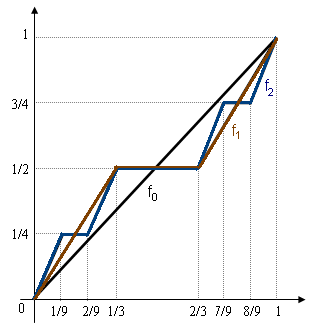mathematics
Mathematics is a field of study that discovers and organizes methods, Mathematical theory, theories and theorems that are developed and Mathematical proof, proved for the needs of empirical sciences and mathematics itself. There are many ar ...
, the Cantor function is an example of a function
Function or functionality may refer to:
Computing
* Function key, a type of key on computer keyboards
* Function model, a structured representation of processes in a system
* Function object or functor or functionoid, a concept of object-orie ...
that is continuous
Continuity or continuous may refer to:
Mathematics
* Continuity (mathematics), the opposing concept to discreteness; common examples include
** Continuous probability distribution or random variable in probability and statistics
** Continuous ...
, but not absolutely continuous
In calculus and real analysis, absolute continuity is a smoothness property of functions that is stronger than continuity and uniform continuity. The notion of absolute continuity allows one to obtain generalizations of the relationship betwe ...
. It is a notorious counterexample
A counterexample is any exception to a generalization. In logic a counterexample disproves the generalization, and does so rigorously in the fields of mathematics and philosophy. For example, the fact that "student John Smith is not lazy" is a c ...
in analysis, because it challenges naive intuitions about continuity, derivative
In mathematics, the derivative is a fundamental tool that quantifies the sensitivity to change of a function's output with respect to its input. The derivative of a function of a single variable at a chosen input value, when it exists, is t ...
, and measure. Although it is continuous everywhere, and has zero derivative almost everywhere, its value still goes from 0 to 1 as its argument goes from 0 to 1. Thus, while the function seems like a constant one that cannot grow, it does indeed monotonically grow.
It is also called the Cantor ternary function, the Lebesgue function, Lebesgue's singular function, the Cantor–Vitali function, the Devil's staircase, the Cantor staircase function, and the Cantor–Lebesgue function. introduced the Cantor function and mentioned that Scheeffer pointed out that it was a counterexample
A counterexample is any exception to a generalization. In logic a counterexample disproves the generalization, and does so rigorously in the fields of mathematics and philosophy. For example, the fact that "student John Smith is not lazy" is a c ...
to an extension of the fundamental theorem of calculus
The fundamental theorem of calculus is a theorem that links the concept of derivative, differentiating a function (mathematics), function (calculating its slopes, or rate of change at every point on its domain) with the concept of integral, inte ...
claimed by Harnack. The Cantor function was discussed and popularized by , , and .
Definition
 To define the Cantor function
To define the Cantor function Cantor set
In mathematics, the Cantor set is a set of points lying on a single line segment that has a number of unintuitive properties. It was discovered in 1874 by Henry John Stephen Smith and mentioned by German mathematician Georg Cantor in 1883.
Throu ...
on ,1 then the Cantor function Properties
The Cantor function challenges naive intuitions about continuity and measure; though it is continuous everywhere and has zero derivativealmost everywhere
In measure theory (a branch of mathematical analysis), a property holds almost everywhere if, in a technical sense, the set for which the property holds takes up nearly all possibilities. The notion of "almost everywhere" is a companion notion to ...
,  Below we define a sequence
Below we define a sequence